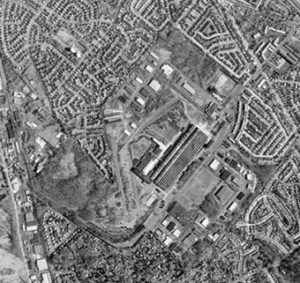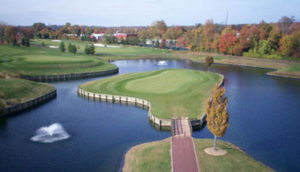The Island Green Country Club in Philadelphia is the result of a long clean-up process and beneficial reuse of a former manufacturing plant site. Jim Blaukovitch, ASGCA, with George E. Ley Co., GCBAA worked with various companies and departments to restore a large expanse of idle land to a productive use, creating a quality golf course while working with numerous restrictions presented by the site and conditions of permitting.

The site of Island Green Country Club before work began
In 1943, the Budd Co. plant opened a 214-acre manufacturing plant with wartime construction of cargo aircraft for the military. The plant later switched to rail car and auto body manufacturing and was renamed Transit America. In 1987, Transit America closed, and the company soon began site assessment. Company officials discovered contamination that permeated the buildings, soil, and ground water. The site contained harmful substances like volatile organic compounds, solvents, cleaning fluids, degreasers, asbestos, and polychlorinated biphenyls.
The Pennsylvania Department of Environmental Protection (DEP) supervised the start of the cleanup process as Transit America removed the contaminants from the ground and began monitoring levels in ground water. In 1995, state legislation paved the way for reuse of the site, establishing a land recycling program known as a “brownfields program.” Brownfields are defined as abandoned, idled, or underused industrial and commercial facilities where expansion or redevelopment is complicated by environmental contamination. The Transit America site was considered a model for the program.
As the golf course architect began work on the site, he ran into issues such as routing of the golf holes, grading for the holes, and creating a viable drainage system. The Transit site had many restrictions: In the 188 acres of the site utilized for the course, routing and grading was limited to areas called “no cut zones,” and Transit America did not allow for any soil to be imported or exported. To comply, the architect designed the course so that cuts and fills would balance within the site.

Island Green Country Club, Philadelphia, Pennsylvania
The site also contained abandoned runways, railroad tracks, and a million square foot building that was the manufacturing plant. The building was constructed of concrete and was built to be bomb proof. The area occupied by the building was determined to be the location for a double-ended driving range. It was estimated that 150,000 cubic feet of soil would be required to cap the concrete slab enough to allow for turf growth. Such an amount of soil was not available on site, so the concrete of the building was crushed, providing enough material to be reused as a base for an artificial turf driving range and to fill an abandoned ravine.
One area of the site approved for excavation provided the source for most of the fill that was required to build the features of the golf course. The area was excavated as much as possible and then became a pond to store water for irrigation of the golf course.
The Island Green project met all of the DEP requirements and allowed Transit America to sell the property as was its original intent. The course opened for public play in 2001. The 18 hole, par 72 course benefits the local community and the environment as a recreational amenity and green space, rather than an abandoned manufacturing plant in a very populated area.
To read more Environmental Case Studies, please visit here.
